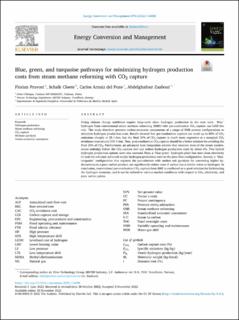| dc.contributor.author | Pruvost, Florian | |
| dc.contributor.author | Cloete, Schalk Willem Petrus | |
| dc.contributor.author | Arnaiz del Pozo, Carlos | |
| dc.contributor.author | Zaabout, Abdelghafour | |
| dc.date.accessioned | 2022-12-12T11:50:23Z | |
| dc.date.available | 2022-12-12T11:50:23Z | |
| dc.date.created | 2022-12-07T10:46:42Z | |
| dc.date.issued | 2022 | |
| dc.identifier.citation | Energy Conversion and Management. 2022, 274 1-12. | en_US |
| dc.identifier.issn | 0196-8904 | |
| dc.identifier.uri | https://hdl.handle.net/11250/3037234 | |
| dc.description.abstract | Rising climate change ambitions require large-scale clean hydrogen production in the near term. “Blue” hydrogen from conventional steam methane reforming (SMR) with pre-combustion CO2 capture can fulfil this role. This study therefore presents techno-economic assessments of a range of SMR process configurations to minimize hydrogen production costs. Results showed that pre-combustion capture can avoid up to 80% of CO2 emissions cheaply at 35 €/ton, but the final 20% of CO2 capture is much more expensive at a marginal CO2 avoidance cost around 150 €/ton. Thus, post-combustion CO2 capture should be a better solution for avoiding the final 20% of CO2. Furthermore, an advanced heat integration scheme that recovers most of the steam condensation enthalpy before the CO2 capture unit can reduce hydrogen production costs by about 6%. Two hybrid hydrogen production options were also assessed. First, a “blue-green” hydrogen plant that uses clean electricity to heat the reformer achieved similar hydrogen production costs to the pure blue configuration. Second, a “blue-turquoise” configuration that replaces the pre-reformer with molten salt pyrolysis for converting higher hydrocarbons to a pure carbon product can significantly reduce costs if carbon has a similar value to hydrogen. In conclusion, conventional pre-combustion CO2 capture from SMR is confirmed as a good solution for kickstarting the hydrogen economy, and it can be tailored to various market conditions with respect to CO2, electricity, and pure carbon prices. | en_US |
| dc.language.iso | eng | en_US |
| dc.publisher | Elsevier | en_US |
| dc.rights | Navngivelse 4.0 Internasjonal | * |
| dc.rights.uri | http://creativecommons.org/licenses/by/4.0/deed.no | * |
| dc.subject | Techno-economic assessment | en_US |
| dc.subject | Methane pyrolysis | en_US |
| dc.subject | CO2 capture | en_US |
| dc.subject | Steam methane reforming | en_US |
| dc.subject | Hydrogen production | en_US |
| dc.title | Blue, green, and turquoise pathways for minimizing hydrogen production costs from steam methane reforming with CO2 capture | en_US |
| dc.title.alternative | Blue, green, and turquoise pathways for minimizing hydrogen production costs from steam methane reforming with CO2 capture | en_US |
| dc.type | Peer reviewed | en_US |
| dc.type | Journal article | en_US |
| dc.description.version | publishedVersion | en_US |
| dc.rights.holder | © 2022 The Authors. Published by Elsevier Ltd. | en_US |
| dc.source.pagenumber | 1-12 | en_US |
| dc.source.volume | 274 | en_US |
| dc.source.journal | Energy Conversion and Management | en_US |
| dc.identifier.doi | 10.1016/j.enconman.2022.116458 | |
| dc.identifier.cristin | 2089925 | |
| dc.source.articlenumber | 116458 | en_US |
| cristin.ispublished | true | |
| cristin.fulltext | original | |
| cristin.qualitycode | 1 | |

